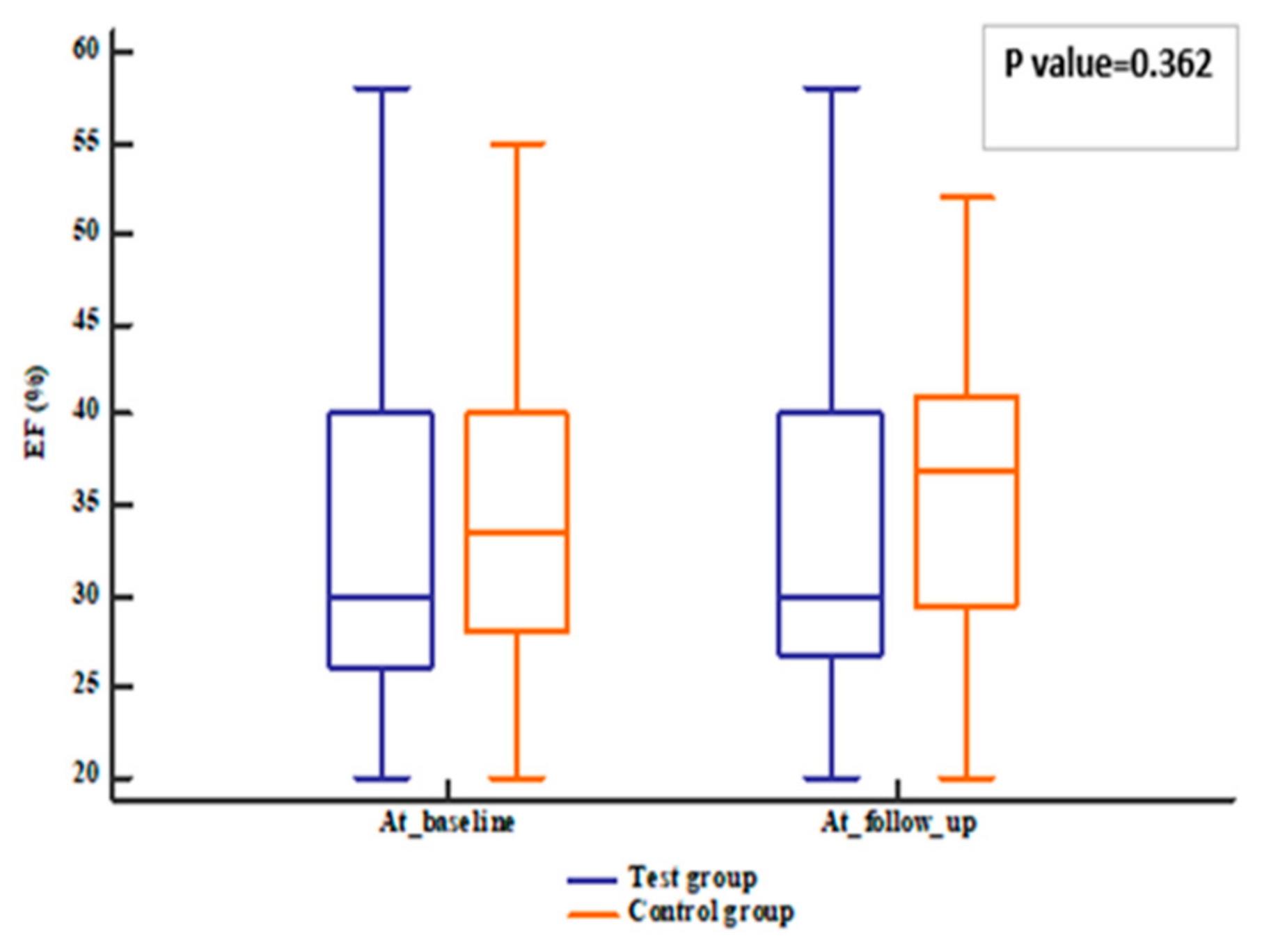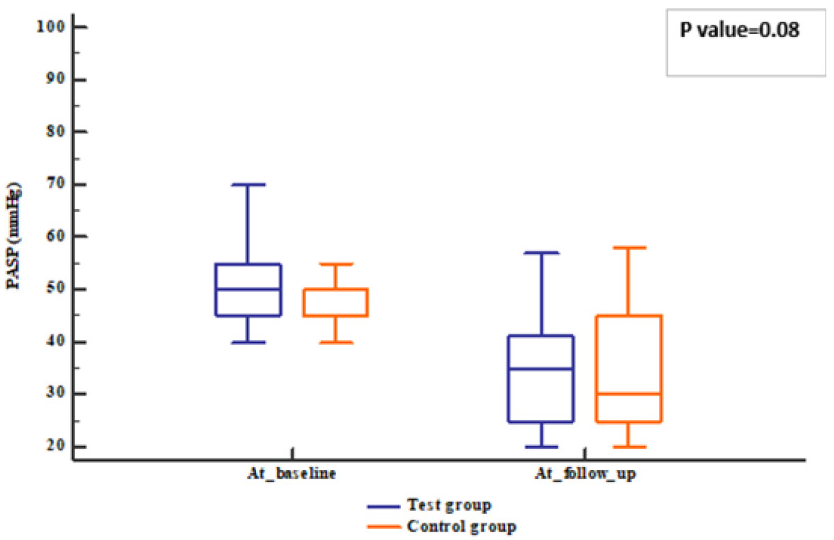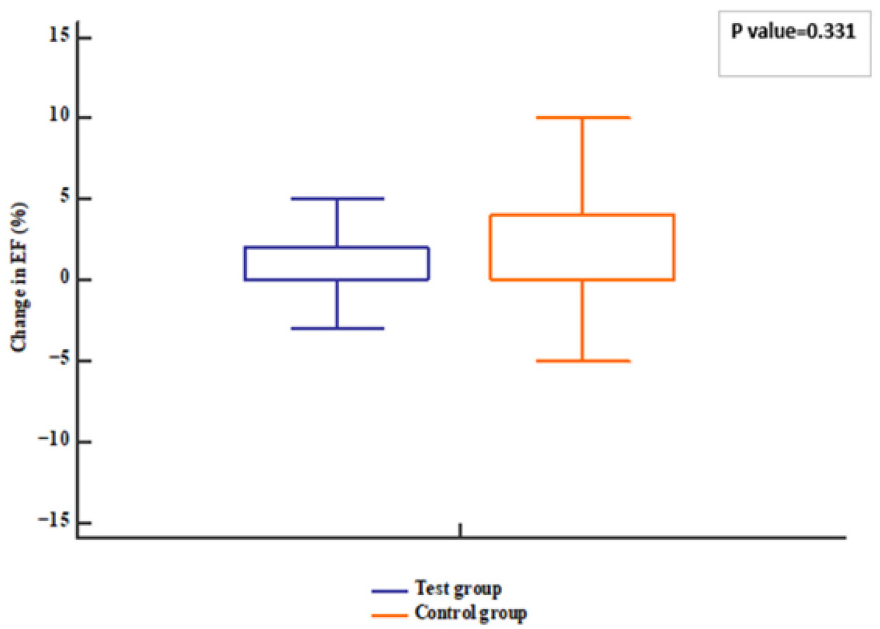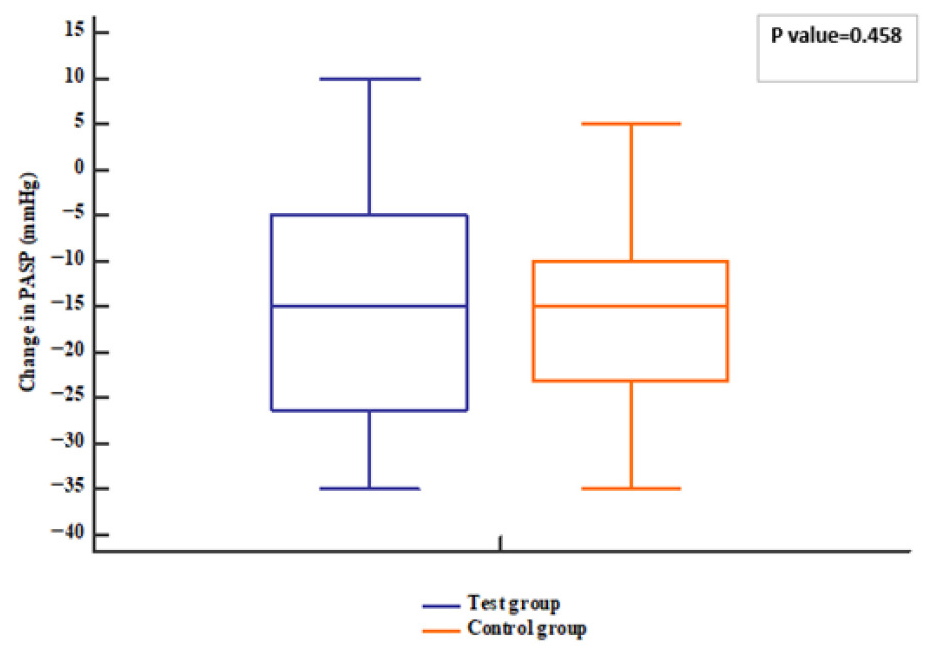Efficacy and Safety of Sildenafil in Combination with Dapagliflozin Versus Dapagliflozin Monotherapy in the Management of Heart Failure with Pulmonary Arterial Hypertension: A Randomized Controlled Trial
Abstract
1. Introduction
2. Results
2.1. Outcome Measures
2.1.1. Effect on Echocardiographic Hemodynamic Parameters
2.1.2. Effect on Cardiac Enzyme, Kidney Function Parameters and Lipid Profile
2.2. Safety Outcomes and Adverse Events
3. Discussion
Limitations and Future Work
4. Patients and Methods
4.1. Design, Setting, and Participants
4.2. Interventions
4.3. Main Outcomes and Measures
4.4. Statistical Analysis
5. Conclusions
Author Contributions
Funding
Institutional Review Board Statement
Informed Consent Statement
Data Availability Statement
Acknowledgments
Conflicts of Interest
Abbreviations
| HF | Heart failure |
| EF | Ejection fraction |
| PH | Pulmonary Arterial Hypertension |
| LVEF | Left ventricle ejection fraction |
| HFrEF | Heart failure with reduced ejection fraction |
| HFpEF | Heart failure with preserved ejection fraction |
| HfmrEF | Heart failure with mildly reduced ejection fractions |
| PH-LHD | PH resulting from left-sided heart disease |
| SGLT2I | Sodium–glucose cotransporter 2 inhibitors |
| PDE-5I | selective Phosphodiesterase Type 5 inhibitor |
| GDMT | Guideline-Directed Medical Therapy |
| NYHA | New York Heart Association |
| FMD | flow-mediated dilatation |
| 6MWT | 6 min walk test |
| AF | atrial fibrillation |
| AEs | adverse events |
| (ipcPH) | isolated pre-capillary pulmonary hypertension |
| Cpc-PH | pre- and post-capillary pulmonary hypertension |
| DAPA | dapagliflozin |
| ESC | European Society of Cardiology |
| cAMP | increasing cyclic adenosine monophosphate |
References
- Bozkurt, B.; Coats, A.J.; Tsutsui, H.; Abdelhamid, C.M.; Adamopoulos, S.; Albert, N.; Anker, S.D.; Gomez-Mesa, J.-E.; Heidenreich, P.; Imamura, T. Endorsed by the Canadian Heart Failure Society, Heart Failure Association of India, Cardiac Society of Australia and New Zealand, and Chinese Heart Failure Association. Eur. J. Heart Fail. 2021, 23, 352–380. [Google Scholar] [CrossRef]
- Lam, C.S.; Solomon, S.D. Classification of heart failure according to ejection fraction: JACC review topic of the week. J. Am. Coll. Cardiol. 2021, 77, 3217–3225. [Google Scholar] [CrossRef] [PubMed]
- Savarese, G.; Becher, P.M.; Lund, L.H.; Seferovic, P.; Rosano, G.M.; Coats, A.J. Global burden of heart failure: A comprehensive and updated review of epidemiology. Cardiovasc. Res. 2022, 118, 3272–3287. [Google Scholar] [CrossRef] [PubMed]
- Virani, S.S.; Alonso, A.; Aparicio, H.J.; Benjamin, E.J.; Bittencourt, M.S.; Callaway, C.W.; Carson, A.P.; Chamberlain, A.M.; Cheng, S.; Delling, F.N. Heart disease and stroke statistics-2021 update: A report from the American Heart Association. Circulation 2021, 143, e254–e743. [Google Scholar] [CrossRef] [PubMed]
- Shahim, B.; Kapelios, C.J.; Savarese, G.; Lund, L.H. Global public health burden of heart failure: An updated review. Card. Fail. Rev. 2023, 9, e11. [Google Scholar] [CrossRef]
- Rasheed, A.; Aslam, S.; Sadiq, H.Z.; Ali, S.; Syed, R.; Panjiyar, B.K. New and Emerging Therapeutic Drugs for the Treatment of Pulmonary Arterial Hypertension: A Systematic Review. Cureus 2024, 16, e68117. [Google Scholar] [CrossRef]
- Bousseau, S.; Fais, R.S.; Gu, S.; Frump, A.; Lahm, T. Pathophysiology and new advances in pulmonary hypertension. BMJ Med. 2023, 2, e000137. [Google Scholar] [CrossRef]
- Dybowska, M.; Barańska, I.; Franczuk, M.; Skoczylas, A.; Szturmowicz, M. Echocardiographic signs of pulmonary hypertension in patients with newly recognized hypersensitivity pneumonitis, prevalence and clinical predictors. J. Thorac. Dis. 2021, 13, 3988. [Google Scholar] [CrossRef]
- Gelzinis, T.A. Pulmonary hypertension in 2021: Part I—Definition, classification, pathophysiology, and presentation. J. Cardiothorac. Vasc. Anesth. 2022, 36, 1552–1564. [Google Scholar] [CrossRef]
- Awada, C.; Boucherat, O.; Provencher, S.; Bonnet, S.; Potus, F. The future of group 2 pulmonary hypertension: Exploring clinical trials and therapeutic targets. Vasc. Pharmacol. 2023, 151, 107180. [Google Scholar] [CrossRef]
- Beghini, A.; Sammartino, A.M.; Papp, Z.; von Haehling, S.; Biegus, J.; Ponikowski, P.; Adamo, M.; Falco, L.; Lombardi, C.M.; Pagnesi, M. 2024 update in heart failure. ESC Heart Fail. 2025, 12, 8–42. [Google Scholar] [CrossRef]
- Keller, D.M.; Ahmed, N.; Tariq, H.; Walgamage, M.; Walgamage, T.; Mohammed, A.; Chou, J.T.-T.; Kałużna-Oleksy, M.; Lesiak, M.; Straburzyńska-Migaj, E. SGLT2 inhibitors in type 2 diabetes mellitus and heart failure—A concise review. J. Clin. Med. 2022, 11, 1470. [Google Scholar] [CrossRef]
- Li, X.; Zhang, Q.; Zhu, L.; Wang, G.; Ge, P.; Hu, A.; Sun, X. Effects of SGLT2 inhibitors on cardiovascular, renal, and major safety outcomes in heart failure: A meta-analysis of randomized controlled trials. Int. J. Cardiol. 2021, 332, 119–126. [Google Scholar] [CrossRef]
- Chen, S.; Coronel, R.; Hollmann, M.W.; Weber, N.C.; Zuurbier, C.J. Direct cardiac effects of SGLT2 inhibitors. Cardiovasc. Diabetol. 2022, 21, 45. [Google Scholar] [CrossRef] [PubMed]
- Palmiero, G.; Cesaro, A.; Vetrano, E.; Pafundi, P.C.; Galiero, R.; Caturano, A.; Moscarella, E.; Gragnano, F.; Salvatore, T.; Rinaldi, L. Impact of SGLT2 inhibitors on heart failure: From pathophysiology to clinical effects. Int. J. Mol. Sci. 2021, 22, 5863. [Google Scholar] [CrossRef] [PubMed]
- Crispino, S.P.; Segreti, A.; Nafisio, V.; Valente, D.; Crisci, F.; Ferro, A.; Cavallari, I.; Nusca, A.; Ussia, G.P.; Grigioni, F. The role of SGLT2-inhibitors across all stages of heart failure and mechanisms of early clinical benefit: From prevention to advanced heart failure. Biomedicines 2025, 13, 608. [Google Scholar] [CrossRef] [PubMed]
- McDonagh, T.A.; Metra, M.; Adamo, M.; Gardner, R.S.; Baumbach, A.; Böhm, M.; Burri, H.; Butler, J.; Čelutkienė, J.; Chioncel, O. 2021 ESC Guidelines for the diagnosis and treatment of acute and chronic heart failure: Developed by the Task Force for the diagnosis and treatment of acute and chronic heart failure of the European Society of Cardiology (ESC) With the special contribution of the Heart Failure Association (HFA) of the ESC. Eur. Heart J. 2021, 42, 3599–3726. [Google Scholar]
- Bauersachs, J.; Soltani, S. Heart failure: Update of the ESC 2023 guidelines. Herz 2023, 49, 19–21. [Google Scholar] [CrossRef]
- Bhogal, S.; Khraisha, O.; Al Madani, M.; Treece, J.; Baumrucker, S.J.; Paul, T.K. Sildenafil for pulmonary arterial hypertension. Am. J. Ther. 2019, 26, e520–e526. [Google Scholar] [CrossRef]
- Beltrán-Gámez, M.E.; Sandoval-Zárate, J.; Pulido, T. Phosphodiesterase-5 inhibitors for the treatment of pulmonary arterial hypertension. Arch. Cardiol. Mex. 2015, 85, 215–224. [Google Scholar]
- Montani, D.; Chaumais, M.-C.; Savale, L.; Natali, D.; Price, L.C.; Jaïs, X.; Humbert, M.; Simonneau, G.; Sitbon, O. Phosphodiesterase type 5 inhibitors in pulmonary arterial hypertension. Adv. Ther. 2009, 26, 813–825. [Google Scholar] [CrossRef]
- Ovchinnikov, A.; Potekhina, A.; Belyavskiy, E.; Ageev, F. Heart failure with preserved ejection fraction and pulmonary hypertension: Focus on phosphodiesterase inhibitors. Pharmaceuticals 2022, 15, 1024. [Google Scholar] [CrossRef] [PubMed]
- Monzón-Herrera, R.; Listorti, F.; Vensentini, N.; Mariani, J. Phosphodiesterase 5 inhibitors for the treatment of heart failure: A systematic review and meta-analysis. Arch. Cardiol. Mex. 2024, 94, 309–323. [Google Scholar] [CrossRef] [PubMed]
- Vaduganathan, M.; Docherty, K.F.; Claggett, B.L.; Jhund, P.S.; de Boer, R.A.; Hernandez, A.F.; Inzucchi, S.E.; Kosiborod, M.N.; Lam, C.S.P.; Martinez, F.; et al. SGLT2 inhibitors in patients with heart failure: A comprehensive meta-analysis of five randomised controlled trials. Lancet 2022, 400, 757–767. [Google Scholar] [CrossRef] [PubMed]
- McMurray, J.J.; Solomon, S.D.; Inzucchi, S.E.; Køber, L.; Kosiborod, M.N.; Martinez, F.A.; Ponikowski, P.; Sabatine, M.S.; Anand, I.S.; Bělohlávek, J.; et al. Dapagliflozin in patients with heart failure and reduced ejection fraction. N. Engl. J. Med. 2019, 381, 1995–2008. [Google Scholar] [CrossRef]
- Zannad, F.; Ferreira, J.P.; Pocock, S.J.; Anker, S.D.; Butler, J.; Filippatos, G.; Brueckmann, M.; Ofstad, A.P.; Pfarr, E.; Jamal, W.; et al. SGLT2 inhibitors in patients with heart failure with reduced ejection fraction: A meta-analysis of the EMPEROR-Reduced and DAPA-HF trials. Lancet 2020, 396, 819–829. [Google Scholar] [CrossRef]
- Girerd, N.; Zannad, F. SGLT2 inhibition in heart failure with reduced or preserved ejection fraction: Finding the right patients to treat. J. Intern. Med. 2023, 293, 550–558. [Google Scholar] [CrossRef]
- Redfield, M.M.; Chen, H.H.; Borlaug, B.A.; Semigran, M.J.; Lee, K.L.; Lewis, G.; LeWinter, M.M.; Rouleau, J.L.; Bull, D.A.; Mann, D.L. Effect of phosphodiesterase-5 inhibition on exercise capacity and clinical status in heart failure with preserved ejection fraction: A randomized clinical trial. JAMA 2013, 309, 1268–1277. [Google Scholar] [CrossRef]
- Hoendermis, E.S.; Liu, L.C.; Hummel, Y.M.; Van Der Meer, P.; De Boer, R.A.; Berger, R.M.; Van Veldhuisen, D.J.; Voors, A.A. Effects of sildenafil on invasive haemodynamics and exercise capacity in heart failure patients with preserved ejection fraction and pulmonary hypertension: A randomized controlled trial. Eur. Heart J. 2015, 36, 2565–2573. [Google Scholar] [CrossRef]
- Cooper, T.J.; Cleland, J.G.; Guazzi, M.; Pellicori, P.; Ben Gal, T.; Amir, O.; Al-Mohammad, A.; Clark, A.L.; McConnachie, A.; Steine, K. Effects of sildenafil on symptoms and exercise capacity for heart failure with reduced ejection fraction and pulmonary hypertension (the SilHF study): A randomized placebo-controlled multicentre trial. Eur. J. Heart Fail. 2022, 24, 1239–1248. [Google Scholar] [CrossRef]
- Dandel, M.; Hetzer, R. Particular challenges in the use of pulmonary vasodilating therapy for patients with pulmonary hypertension secondary to left heart disease. Letter regarding the article ‘Effects of sildenafil on symptoms and exercise capacity for heart failure with reduced ejection fraction and pulmonary hypertension (the SilHF study): A randomized placebo-controlled multicentre trial’. Eur. J. Heart Fail. 2022, 24, 1990. [Google Scholar] [PubMed]
- Monzón-Herrera, R.; Listorti, F.; Vensentini, N.; Mariani, J. Inhibidores de la fosfodiesterasa 5 para el tratamiento de la insuficiencia cardiaca: Revisión sistemática y metaanálisis de ensayos clínicos aleatorizados. Arch. Cardiol. Mex. 2024, 94, 309. [Google Scholar] [CrossRef] [PubMed]
- Vitale, G.; Romano, G.; Di Franco, A.; Caccamo, G.; Nugara, C.; Ajello, L.; Storniolo, S.; Sarullo, S.; Agnese, V.; Giallauria, F. Early effects of sacubitril/valsartan on exercise tolerance in patients with heart failure with reduced ejection fraction. J. Clin. Med. 2019, 8, 262. [Google Scholar] [CrossRef] [PubMed]
- Albert, N.M.; Bena, J.F.; Morrison, S.L.; Williams, J.B.; Faulkenberg, K.; Khairnar, R.; Martyn, T. Clinical outcomes of sacubitril-valsartan versus angiotensin converting enzyme inhibitor or angiotensin receptor blocker among patients with heart failure and ejection fraction at/less than 60%: A retrospective, observational, parallel cohort, multi-group study. Heart Lung 2025, 73, 64–73. [Google Scholar]
- Behling, A.; Rohde, L.E.; Colombo, F.C.; Goldraich, L.A.; Stein, R.; Clausell, N. Effects of 5′-phosphodiesterase four-week long inhibition with sildenafil in patients with chronic heart failure: A double-blind, placebo-controlled clinical trial. J. Card. Fail. 2008, 14, 189–197. [Google Scholar] [CrossRef]
- Guazzi, M.; Samaja, M.; Arena, R.; Vicenzi, M.; Guazzi, M.D. Long-term use of sildenafil in the therapeutic management of heart failure. J. Am. Coll. Cardiol. 2007, 50, 2136–2144. [Google Scholar] [CrossRef]
- Lewis, G.D.; Shah, R.; Shahzad, K.; Camuso, J.M.; Pappagianopoulos, P.P.; Hung, J.; Tawakol, A.; Gerszten, R.E.; Systrom, D.M.; Bloch, K.D. Sildenafil improves exercise capacity and quality of life in patients with systolic heart failure and secondary pulmonary hypertension. Circulation 2007, 116, 1555–1562. [Google Scholar] [CrossRef]
- Smith, B.P.; Babos, M. Sildenafil; StatPearls Publishing: Treasure Island, FL, USA, 2020. [Google Scholar]
- Armillotta, M.; Angeli, F.; Paolisso, P.; Belmonte, M.; Raschi, E.; Di Dalmazi, G.; Amicone, S.; Canton, L.; Fedele, D.; Suma, N. Cardiovascular therapeutic targets of sodium-glucose co-transporter 2 (SGLT2) inhibitors beyond heart failure. Pharmacol. Ther. 2025, 270, 108861. [Google Scholar] [CrossRef]
- Belyavskiy, E.; Ovchinnikov, A.; Potekhina, A.; Ageev, F.; Edelmann, F. Phosphodiesterase 5 inhibitor sildenafil in patients with heart failure with preserved ejection fraction and combined pre-and postcapillary pulmonary hypertension: A randomized open-label pilot study. BMC Cardiovasc. Disord. 2020, 20, 408. [Google Scholar] [CrossRef]
- Gelfman, D.M. Diagnosis: Pulmonary Hypertension. Next Steps. Am. J. Med. 2025, 138, 941–945. [Google Scholar] [CrossRef]
- Siddiqui, Z.; Hadid, S.; Frishman, W.H. SGLT-2 Inhibitors: Focus on Dapagliflozin. Cardiol. Rev. 2024, 32, 1010–1097. [Google Scholar] [CrossRef]
- Morrison, L.; Gabison, J.; Oshman, L. GLP-1 RAs and SGLT2-Is to lower glucose and reduce the risk of Cardiovascular and Diabetic kidney disease. J. Am. Board Fam. Med. 2024, 37, 372–382. [Google Scholar] [CrossRef] [PubMed]
- Weir, C.; Jan, A. BMI Classification Percentile and Cut off Points; StatPearls: Treasure Island, CA, USA, 2023. [Google Scholar]
- Heidenreich, P.A.; Bozkurt, B.; Aguilar, D.; Allen, L.A.; Byun, J.J.; Colvin, M.M.; Deswal, A.; Drazner, M.H.; Dunlay, S.M.; Evers, L.R. 2022 AHA/ACC/HFSA guideline for the management of heart failure: A report of the American College of Cardiology/American Heart Association Joint Committee on Clinical Practice Guidelines. J. Am. Coll. Cardiol. 2022, 79, e263–e421. [Google Scholar] [CrossRef]
- Solomon, S.D.; McMurray, J.J.; Claggett, B.; de Boer, R.A.; DeMets, D.; Hernandez, A.F.; Inzucchi, S.E.; Kosiborod, M.N.; Lam, C.S.; Martinez, F. Dapagliflozin in heart failure with mildly reduced or preserved ejection fraction. N. Engl. J. Med. 2022, 387, 1089–1098. [Google Scholar] [CrossRef]





| Test Group (n = 45) | Control Group (n = 48) | Total (n = 93) | p Value | MD or RR (95%CI) | ||
|---|---|---|---|---|---|---|
| Demographic Data and Medical History | ||||||
| Age (years) | 51 (46–56) | 54.5 (45–62.75) | 54 (45–60) | 0.287 | 3 (−2: 7) | |
| Sex | Male | 30 (66.67%) | 29 (60.42%) | 59 (63.44%) | 0.531 | 1.1 (0.81:1.5) |
| Female | 15 (33.33%) | 19 (39.58%) | 34 (36.56%) | |||
| Diabetes mellitus | 3 (6.67%) | 4 (8.33%) | 7 (7.53%) | 1 | 0.87 (0.36–2.12) | |
| PCI | 3 (6.67%) | 6 (12.5%) | 9 (9.68%) | 0.487 | 0.67 (0.26–1.7) | |
| CKD | 0 (0%) | 2 (4.17%) | 2 (2.15%) | 0.495 | --- | |
| HCV | 1 (2.22%) | 0 (0%) | 1 (1.08%) | 0.483 | --- | |
| AF | 7 (15.56%) | 4 (8.33%) | 11 (11.82%) | 0.345 | 1.37 (0.83–2.27) | |
| Smoking | 5 (11.1%) | 4 (8.33%) | 9 (9.6%) | 0.734 | 1.17 (0.62–2.18) | |
| New York Heart Association (NYHA) | ||||||
| NYHA class II | 15 (33.33%) | 17 (35.41%) | 32 (34.4%) | 1 | 0.94 (0.54:1.65) | |
| NYHA class III | 30 (66.6%) | 31 (64.58%) | 61 (65.59%) | |||
| Kidney function tests | ||||||
| Creatinine (mg/dL) | 1 (0.9–1.25) | 1.05 (0.8–1.26) | 1 (0.9–1.25) | 0.379 | −0.10 (−0.20–0.10) | |
| Urea (mg/dL) | 36 (25.5–53) | 35.2 (26.5–44) | 36 (25.5–48.7) | 0.294 | −3.74 (−11–3) | |
| Liver function tests | ||||||
| ALT (U/L) | 24 (15–31) | 21.85 (16.53 −32.48) | 23 (16–31.7) | 0.761 | 0.7 (−3.6–4.2) | |
| AST (U/L) | 26 (24.8–31) | 25.95 (20–30) | 26 (22–30) | 0.310 | −1.45 (−4.7–1.8) | |
| Lipid profile | ||||||
| Cholesterol (mg/dL) | 160 (156–200) | 158 (154–191.25) | 160 (154–192) | 0.387 | −2 (−14.8–6) | |
| HDL (mg/dL) | 46 (42–50) | 49 (41–54) | 49 (42–54) | 0.616 | 0 (−1–5) | |
| LDL (mg/dL) | 92.6 (76–119) | 86 (60–122) | 91 (63.6–122) | 0.352 | −5.1 (−20.2–9.2) | |
| Triglyceride (mg/dL) | 134 (118.52–177) | 134 (91.5–178.05) | 134 (108–178) | 0.630 | −2 (−30.8–16.26) | |
| Cardiac enzymes | ||||||
| Troponin (ng/mL) | 0.1 (0.1–0.11) | 0.1 (0.1–0.12) | 0.1 (0.1–0.14) | 0.625 | 0 (−0.01–0) | |
| Echocardiographic findings | ||||||
| EF (%) | 30 (26–40) | 33.5 (28.5–40) | 30 (27–40) | 0.362 | 1 (−2–5) | |
| PASP (mmHg) | 50 (45–55) | 50 (45–50) | 50 (45–53) | 0.080 | −2 (−5–0) | |
| Treatment | ||||||
| ACEi or ARB | 41 (91.6%) | 45 (93.75%) | 86 (92.47%) | 0.708 | 0.83 (0.423–1.64) | |
| Beta-blocker | 43 (95.5%) | 46 (95.83%) | 89 (95.69%) | 1 | 0.97 (0.35–2.64) | |
| Aldosterone antagonist | 38 (84.44%) | 40 (83.33%) | 78 (83.87%) | 0.884 | 1.01 (0.85:1.21) | |
| Loop diuretic | 39 (86.66%) | 38 (79.16%) | 77 (82.79%) | 0.338 | 1.09 (0.91:1.32) | |
| Thiazide diuretic | 1 (2.22%) | 2 (4.16%) | 3 (3.22%) | 1 | 1.47 (0.29–7.37) | |
| Statins | 15 (33.33%) | 17 (35.42%) | 32 (34.41%) | 0.833 | 0.94 (0.54:1.65) | |
| Test Group (n = 45) | Control Group (n = 48) | p Value | MD (95% CI) | |||
|---|---|---|---|---|---|---|
| Lipid profile | Change in cholesterol (mg/dL) | Median | −31 | −6 | 0.192 | 12.06 (−5–30.2) |
| IQR | −68–3.2 | −35.3–2 | ||||
| Change in HDL (mg/dL) | Median | 2 | 1.5 | 0.152 | −2 (−5–0.8) | |
| IQR | −1–10 | −3–5 | ||||
| Change in LDL (mg/dL) | Median | −30.5 | −10.75 | 0.110 | 12.4 (−2.5–29.9) | |
| IQR | −83.4–−2.3 | −38.95–−0.95 | ||||
| Change in triglyceride (mg/dL) | Median | 3 | −3.2 | 0.598 | −4.5 (−20.5–14.5) | |
| IQR | −24–18 | −33.5–14.6 | ||||
| Cardiac enzymes | Change in troponin (ng/mL) | Median | 0 | 0 | 0.574 | 0 (0–0.01) |
| IQR | −0.01–0.01 | −0.01–0.01 | ||||
| Kidney function | Change in creatinine (mg/dL) | Median | 0 | 0 | 0.923 | 0 (−0.14–0.2) |
| IQR | −0.1–0.1 | −0.3–0.4 | ||||
| Causes of Hospitalization | Test Group (n = 45) | Control Group (n = 48) | p Value | RR (95%CI) |
|---|---|---|---|---|
| Decompensated heart failure due to AF | 1 (2.22%) | 1 (2.08) | 0.524 | ---- |
| Heart failure and ACS | 2 (4.44%) | 1 (2.08%) | ||
| DCM and syncopal attack | 0 (0%) | 1 (2.08%) | ||
| Stroke | 0 (0%) | 1 (2.08%) |
Disclaimer/Publisher’s Note: The statements, opinions and data contained in all publications are solely those of the individual author(s) and contributor(s) and not of MDPI and/or the editor(s). MDPI and/or the editor(s) disclaim responsibility for any injury to people or property resulting from any ideas, methods, instructions or products referred to in the content. |
© 2025 by the authors. Licensee MDPI, Basel, Switzerland. This article is an open access article distributed under the terms and conditions of the Creative Commons Attribution (CC BY) license (https://creativecommons.org/licenses/by/4.0/).
Share and Cite
Abdallah, E.M.; Kamal, M.; Elkhashab, K.; Mohamed, M.A.; Binsaleh, A.Y.; Mohsen, M.; Hussein, R.R.S. Efficacy and Safety of Sildenafil in Combination with Dapagliflozin Versus Dapagliflozin Monotherapy in the Management of Heart Failure with Pulmonary Arterial Hypertension: A Randomized Controlled Trial. Pharmaceuticals 2025, 18, 1663. https://doi.org/10.3390/ph18111663
Abdallah EM, Kamal M, Elkhashab K, Mohamed MA, Binsaleh AY, Mohsen M, Hussein RRS. Efficacy and Safety of Sildenafil in Combination with Dapagliflozin Versus Dapagliflozin Monotherapy in the Management of Heart Failure with Pulmonary Arterial Hypertension: A Randomized Controlled Trial. Pharmaceuticals. 2025; 18(11):1663. https://doi.org/10.3390/ph18111663
Chicago/Turabian StyleAbdallah, Esraa M., Marwa Kamal, Khaled Elkhashab, Mahmoud A. Mohamed, Ammena Y. Binsaleh, Marwa Mohsen, and Raghda R. S. Hussein. 2025. "Efficacy and Safety of Sildenafil in Combination with Dapagliflozin Versus Dapagliflozin Monotherapy in the Management of Heart Failure with Pulmonary Arterial Hypertension: A Randomized Controlled Trial" Pharmaceuticals 18, no. 11: 1663. https://doi.org/10.3390/ph18111663
APA StyleAbdallah, E. M., Kamal, M., Elkhashab, K., Mohamed, M. A., Binsaleh, A. Y., Mohsen, M., & Hussein, R. R. S. (2025). Efficacy and Safety of Sildenafil in Combination with Dapagliflozin Versus Dapagliflozin Monotherapy in the Management of Heart Failure with Pulmonary Arterial Hypertension: A Randomized Controlled Trial. Pharmaceuticals, 18(11), 1663. https://doi.org/10.3390/ph18111663






